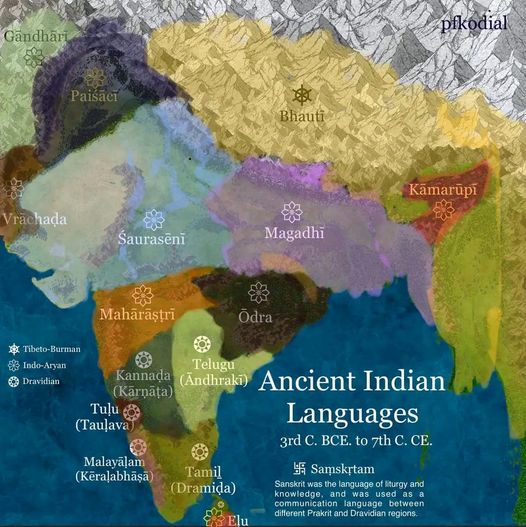



Let's briefly explore some pertinent details of each of these languages.
TIBETO-BURMAN
---------------------------
1. Bhauti:
- Region: Likely the Himalayan region, including parts of modern-day Sikkim and Bhutan.
- Age: The Tibeto-Burman languages have ancient origins, though specific ages for Bhauti are not well-documented.
- Details: Part of a family of languages spoken by various ethnic groups in the Himalayas.
INDO-ARYAN
--------------------
2. Gandhari:
- Region: Ancient Gandhara, corresponding to present-day northwest Pakistan and eastern Afghanistan.
- Age: Flourished around the 3rd century BCE to 3rd century CE.
- Details: Known for the Gandhari Prakrit, written using the Kharosthi script; influential in early Buddhist texts.
3. Paisachi:
- Region: Possibly in the northwest of the Indian subcontinent.
- Age: Mentioned as early as the 5th century CE; details are sparse.
- Details: Considered a literary language with few surviving examples, often cited in folklore.
4. Sauraseni:
- Region: Around the central region of India, including what is now Madhya Pradesh.
- Age: Used as a literary Prakrit language in plays and poetry, around 1st century CE onwards.
- Details: Ancestor of the Western Hindi languages, including modern-day Hindi and Punjabi.
5. Magadhi:
- Region: Ancient Magadha, roughly the modern state of Bihar in India.
- Age: Prevalent in the 1st millennium BCE, continuing into the first half of the 1st millennium CE.
- Details: Associated with the spread of Buddhism and Jainism, and is a precursor to languages like Bengali, Assamese, and Odia.
6. Kamarupi:
- Region: Ancient Kamarupa, corresponding to modern Assam and parts of Bengal.
- Age: Flourished from the 4th to the 12th century CE.
- Details: An early form of Assamese, influential in the development of other Eastern Indo-Aryan languages.
7. Maharashtri:
- Region: Region corresponding to modern-day Maharashtra and neighbouring states.
- Age: Dominant around the 1st millennium BCE to 5th century CE.
- Details: Considered the "mother of Marathi," with a significant body of early literature, including the celebrated 'Gatha Saptashati'.
8. Odra:
- Region: Region around modern-day Odisha.
- Age: Known from the 10th century onwards, with inscriptions dating back to the 6th century.
- Details: Precursor to the Odia language, with distinctive script and literature.
9. Elu:
- Region: Ancient Sri Lanka.
- Age: Considered to be the earliest form of the Sinhalese language, with origins in the 3rd century BCE.
- Details: Shows significant influence from the Pali language, holding an important place in Sri Lankan history and culture.
DRAVIDIAN
------------------
10. Kannada:
- Region: Primarily spoken in the state of Karnataka, India.
- Age: Old Kannada inscriptions date from the 5th century CE.
- Details: Rich literary tradition with extensive classical and medieval literature.
11. Telugu:
- Region: Andhra Pradesh and Telangana states in India.
- Age: Inscriptions date back to the 6th century CE.
- Details: Has a strong literary tradition with distinct script; often called the "Italian of the East."
12. Tulu:
- Region: Coastal Karnataka, specifically the Dakshina Kannada and Udupi districts.
- Age: The earliest available Tulu writing dates to around the 15th century CE.
- Details: Has its own script and a rich oral literature tradition with folk songs and stories.
13. Malayalam:
- Region: Kerala state and the Union Territory of Lakshadweep in India.
- Age: Separated from Middle Tamil around the 9th century CE.
- Details: Malayalam has a unique script and a rich literary and cultural tradition.
14. Tamil:
- Region: Tamil Nadu in India, and Northern and Eastern Sri Lanka.
- Age: Tamil literature dates back to at least 500 BCE.
- Details: Recognized as one of the longest-surviving classical languages in the world with an extensive body of literature.
SANSKRIT (Also Indo-Aryan)
--------------------------------------------
15. Sanskrit:
- Region: Pan-Indian subcontinent and beyond.
- Age: Vedic Sanskrit can be traced back to around 1500 BCE; Classical Sanskrit flourished from about 500 BCE.
- Details: The classical language of India, used extensively in literature and liturgy. It was the lingua franca for intellectual, spiritual, and religious discourse.
(collected from Facebook Krishna Sen)
Author: Saikat Bhattacharya